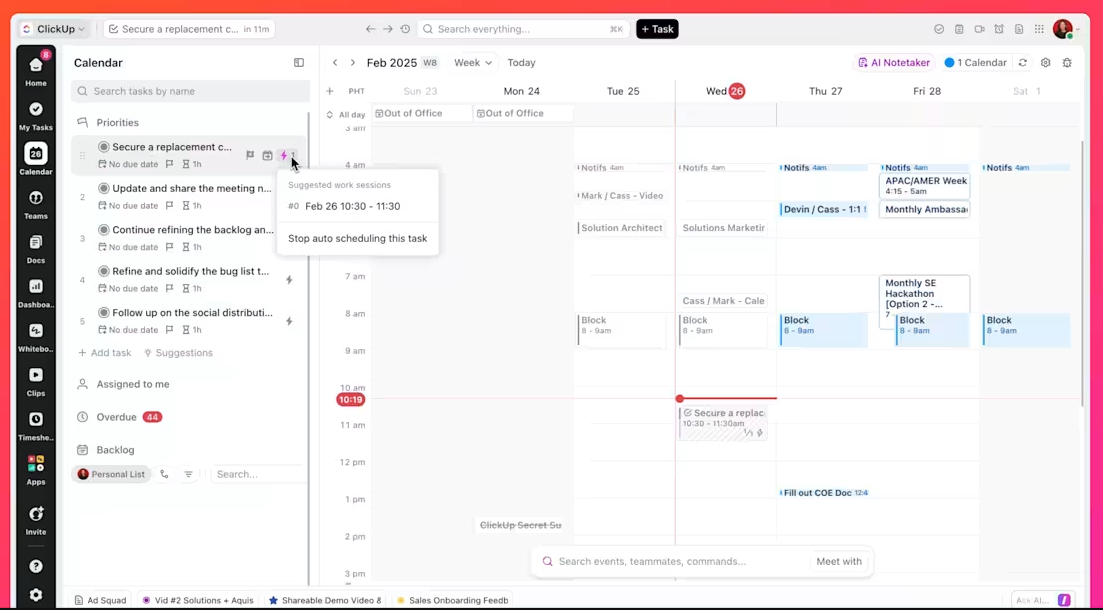It’s 10 AM, and your day is already off to a chaotic start. Between a mountain of tasks and a calendar full of back-to-back meetings, staying on track seems impossible.
A reliable schedule maker can transform this daily puzzle into a smooth operation.
While premium scheduling tools flood the market, smart planning doesn’t need to be expensive. Some free alternatives pack enough power to rival their paid counterparts.
This blog post explores 11 free scheduling tools that excel in simplicity, adaptability, and practical features (🍪 bonus schedule templates included). Let’s get into it! 💪🏼
- What Is a Schedule Maker?
- Benefits of Using a Schedule Maker
- What Should You Look for in a Schedule Maker?
- The 11 Best Schedule Makers
- 1. ClickUp (Best for creating customizable schedules and task management)
- 2. Calendly (Best for automated meeting scheduling and client appointments)
- 3. Google Calendar (Best for collaborative team scheduling and Google Workspace integration)
- 4. Asana (Best for project-based schedule management and team coordination)
- 5. HubSpot (Best for sales-driven scheduling and customer journey management)
- 6. Canva (Best for visual schedule design and content planning)
- 7. ZoomShift (Best for employee shift management and labor cost control)
- 8. Google Sheets (Best for custom schedule creation and data-driven planning)
- 9. Sling (Best for small business staff scheduling and team communication)
- 10. Homebase (Best for comprehensive small business operations management)
- 11. Doodle (Best for quick consensus-based meeting coordination)
⏰ 60-Second Summary
- ClickUp (Best for creating customizable schedules and task management)
- Calendly (Best for automated meeting scheduling and client appointments)
- Google Calendar (Best for collaborative team scheduling and Google Workspace integration)
- Asana (Best for project-based schedule management and team coordination)
- HubSpot (Best for sales-driven scheduling and customer journey management)
- Canva (Best for visual schedule design and content planning)
- ZoomShift (Best for employee shift management and labor cost control)
- Google Sheets (Best for custom schedule creation and data-driven planning)
- Sling (Best for small business staff scheduling and team communication)
- Homebase (Best for comprehensive small business operations management)
- Doodle (Best for quick consensus-based meeting coordination)
What Is a Schedule Maker?
A schedule maker is a tool designed to refine the process of organizing tasks, events, or class schedules. It allows individuals and teams to plan their time effectively, ensuring every commitment finds its place.
When you use a schedule maker to create a weekly schedule, you take control of your time and reduce unnecessary stress. Everything is laid out in one place, making it easier to focus and stay productive.
Benefits of Using a Schedule Maker
A schedule maker offers several key benefits to help you master schedule project management. These include:
- Optimized resource allocation: Strategically assigning time and resources to each task helps avoid wasted effort and keeps everything on track
- Conflict-free scheduling: Providing a clear overview of tasks and meetings helps prevent overlaps and reduces last-minute reshuffles
- Time-saving features: Using drag-and-drop tools, reminders, and automation minimizes planning time and maximizes productivity
- Accurate records: Maintaining a detailed log of all changes helps track progress and ensure compliance
- Streamlined communication: Sharing project schedules keeps teams aligned and informed, ensuring everyone works toward common goals without confusion
- Flexible adjustments: Modifying plans quickly allows you to accommodate unexpected changes without disrupting your workflow
- Organized structures: Eliminating guesswork through clear planning helps you tackle tasks with confidence and focus
💡 Pro Tip: Add short breaks or buffer times to your schedule to recharge and handle unexpected delays effectively.
What Should You Look for in a Schedule Maker?
Choosing the right schedule maker depends on features that make your planning smoother and more effective. Look for tools that offer:
- Task prioritization: A good schedule maker helps you organize tasks based on importance, so you can focus on what matters most
- Visual calendar views: Clear, easy-to-read layouts make it simple to track your daily, weekly, or monthly plans at a glance
- Automated reminders: Alerts ensure you never miss a meeting, task, or deadline, making it easier to stay focused and productive
- Collaboration features: Shared calendars and scheduling tools let teams coordinate easily, avoiding meeting conflicts and improving communication
- Customizable templates: Pre-designed schedules make setup quick, while adjustable options allow you to tailor plans to your specific needs
How we review software at ClickUp
Our editorial team follows a transparent, research-backed, and vendor-neutral process, so you can trust that our recommendations are based on real product value.
Here’s a detailed rundown of how we review software at ClickUp.
The 11 Best Schedule Makers
Finding the right schedule maker can feel overwhelming when there are so many options out there. The good news is that you don’t have to test them all yourself.
We’ve rounded up the best tools that make scheduling easy, efficient, and tailored to your needs. Let’s explore and find the perfect one for you! 👇
1. ClickUp (Best for creating customizable schedules and task management)
ClickUp is the everything app for work, offering individuals and teams an intuitive way to search, create, and manage schedules.
Its versatile features cater to diverse needs, from planning daily routines to managing large-scale collaborative efforts, making it a go-to choice for anyone seeking a free and customizable scheduling solution.
ClickUp Calendar
ClickUp’s Calendar seamlessly integrates your tasks and schedule, providing a unified view of your day. By connecting your existing calendar, you can leverage features like multi-timezone support and automated time blocking for priority tasks, all within the same platform.
This integration facilitates efficient scheduling and ensures alignment between meetings, team schedules, and task completion.
For example, a college student juggling multiple assignment deadlines can create ClickUp Tasks for each assignment, set due dates, and drag these tasks across the calendar to adjust priorities when their workload changes.
Similarly, a small team planning a product launch can use the Calendar to map out deadlines, add milestones, and ensure meetings align with key dates. Armed with AI-powered scheduling insights, this nifty feature can even suggest tasks and meetings based on your priorities and backlog.
Meetings become more efficient thanks to ClickUp’s integrated tools. For example, a professor hosting a recurring study group can use ClickUp Meetings to set up weekly sessions.
ClickUp AI Notetaker and ClickUp Brain

Stuck taking notes amid a busy schedule? Add ClickUp’s AI Notetaker to the meetings to capture summaries, action items, and key details in neatly structured, private ClickUp Docs. Additionally, ClickUp Brain, the integrated AI assistant, helps you turn those action items into tasks via ClickUp Tasks, complete with assignees, due dates, and dependencies. No more frantic meeting follow-ups, just seamless execution.

For example, a freelance writer handling multiple clients can use task lists to break projects into smaller steps, like research, drafting, and edits. This ensures clear deadlines, organized workflows, and easy progress tracking.
ClickUp Calendar Integration
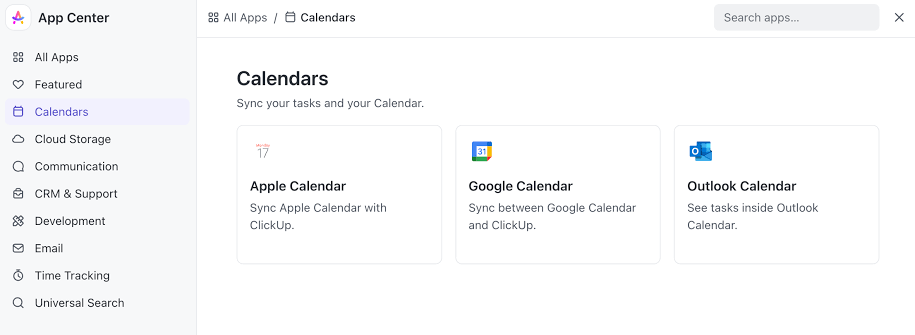
The ClickUp Calendar Integration lets you sync schedules across your computer, Google Calendar, Outlook, or iCloud, ensuring you never miss an important meeting or deadline.
A working professional can sync their Tasks with Google Calendar to receive reminders for client presentations while also keeping track of personal commitments like doctor appointments—all in one view.
⚡️ Template archive: ClickUp offers a ton of free templates to help you set up schedules quickly and efficiently. For individual planning, the ClickUp Schedule Blocking Template allows you to allocate dedicated time blocks for focused tasks, ensuring maximum productivity.
For teams, the ClickUp Team Schedule Template simplifies collaborative planning by organizing responsibilities and deadlines in a clear and structured format.
ClickUp best features
- Visualize task status (e.g., to-do, in progress, completed) directly on your schedule to ensure everyone is aligned
- Use ClickUp Reminders to schedule task updates, project deadlines, or follow-ups. Sync them across devices and receive notifications in your preferred format, like emails or mobile alerts
- Assign ClickUp Task Priorities to ensure important deadlines take precedence over less critical ones
- Share your calendar with others to keep everyone in the loop and make adjustments in real time
- Track time spent on tasks and meetings directly in your schedule using ClickUp Time Tracking, providing a clearer view of productivity
- Add ClickUp Custom Fields to Tasks, such as location or specific instructions, to better track and organize your schedule
ClickUp limitations
- The comprehensive task and meeting window may take some time to get used to
ClickUp pricing
ClickUp ratings and reviews
- G2: 4.7/5 (9,000+ reviews)
- Capterra: 4.6/5 (4,000+ reviews)
To put ClickUp’s vast capabilities in perspective, take the case of RevPartners. The organization cut project delivery time by 64% with ClickUp, using customizable workflows, automations, and schedule templates to simplify management and drive better results.
💡 Pro Tip: Set up a calendar reminder for a year from now with a ‘time capsule’ task. This could be a reflection on what you’re working on today or something you want to revisit—use it as a way to connect the present with future goals.
2. Calendly (Best for automated meeting scheduling and client appointments)
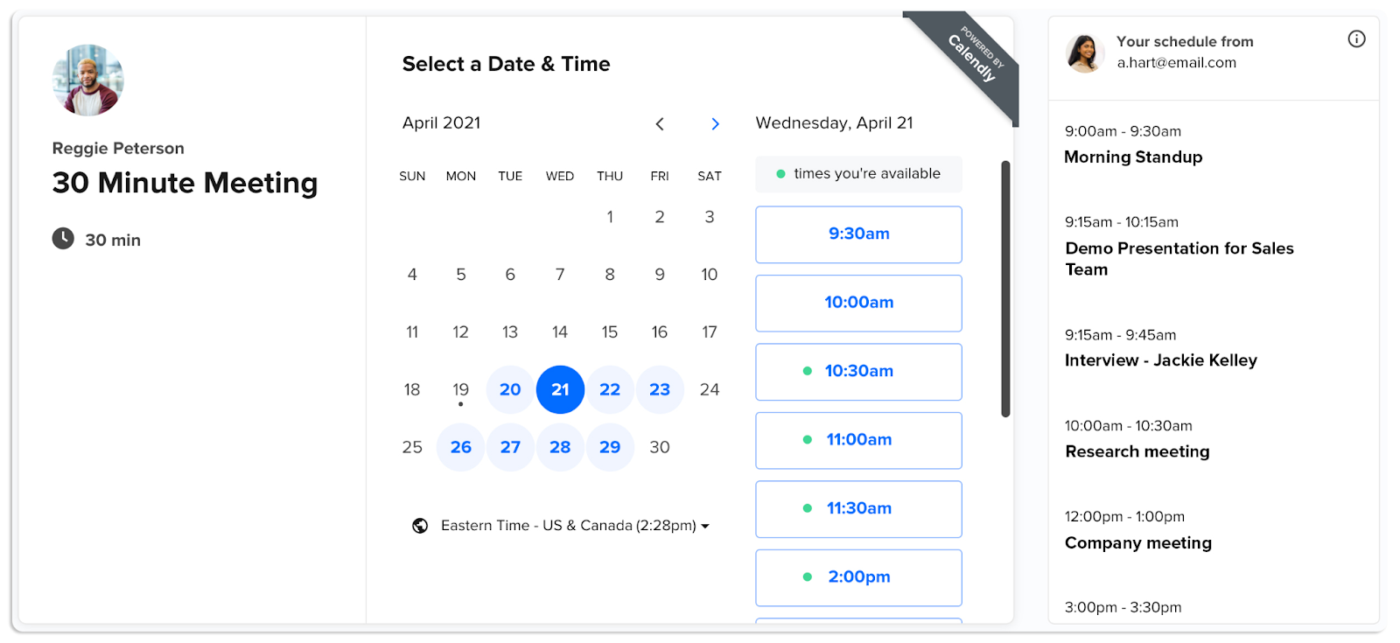
Calendly simplifies scheduling by automating availability and booking workflows, eliminating the need for back-and-forth emails. It integrates effortlessly with popular calendar platforms like Google and Outlook, making it suitable for businesses and professionals who need efficient, client-facing scheduling solutions.
The customizable booking rules and round-robin scheduling make it a good option for teams that handle multiple clients or high volumes of meetings.
Calendly best features
- Automate meeting scheduling with flexible booking rules and availability preferences
- Distribute meetings across team members through round-robin scheduling
- Customize buffer times between meetings to prevent overscheduling and ensure focus
- Set up personalized booking links with custom branding to maintain a professional appearance
Calendly limitations
- Advanced features like workflows and payment integration are restricted to premium tiers
- Requires time to configure complex scheduling rules for team use
Calendly pricing
- Free
- Standard: $12/month per user
- Teams: $20/month per user
- Enterprise: Starts at $15K annually
Calendly ratings and reviews
- G2: 4.7/5 (2,280+ reviews)
- Capterra: 4.7/5 (3,900+ reviews)
🧠 Fun Fact: The first mechanical clocks, built between 1270 and 1300 in northern Italy and southern Germany, were tower clocks powered by weights. They lacked dials or hands and marked time by striking bells.
3. Google Calendar (Best for collaborative team scheduling and Google Workspace integration)
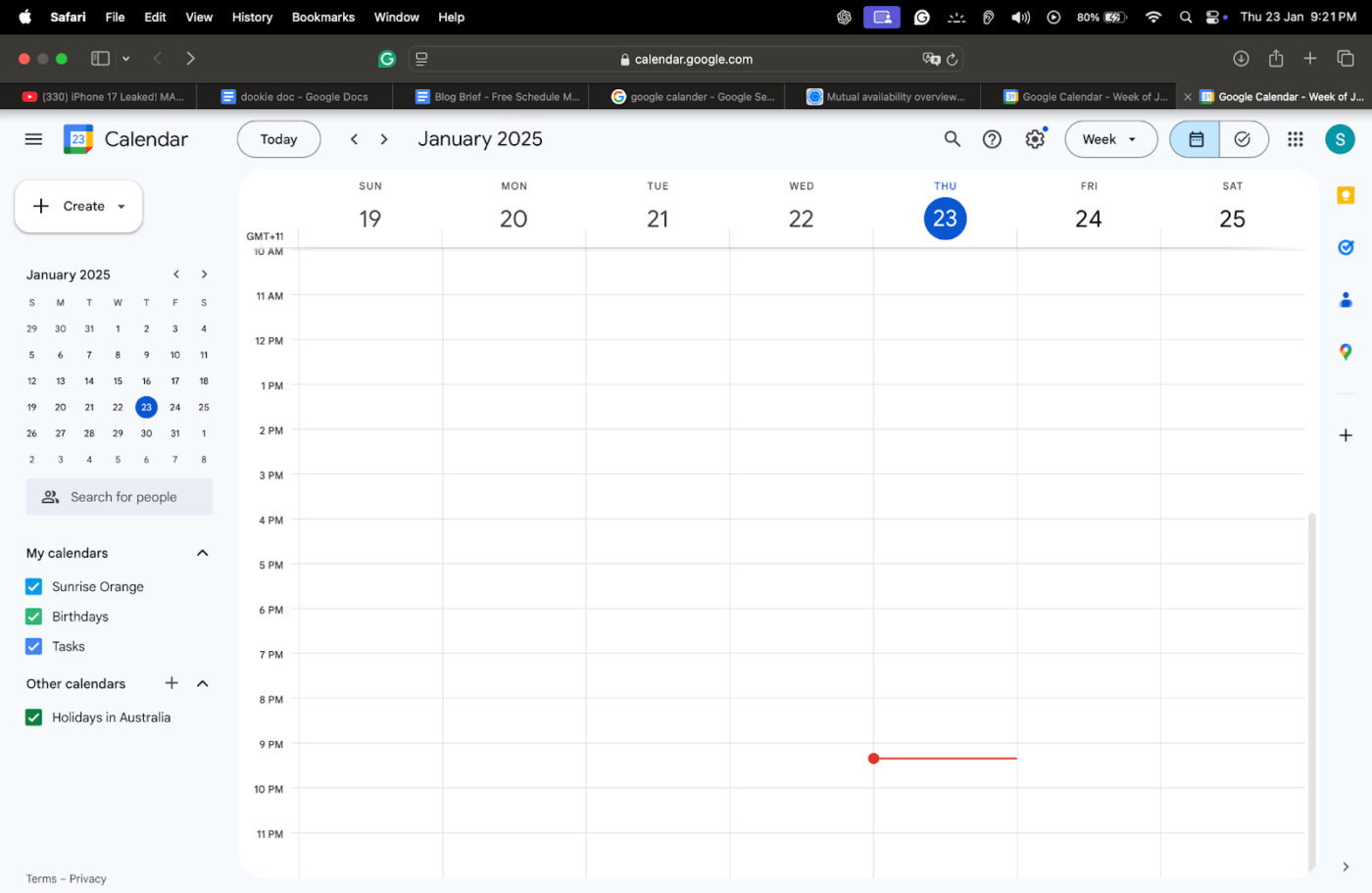
Google Calendar stands out for its seamless integration with the Google Workspace ecosystem, providing real-time scheduling solutions for personal, school, and professional use. Its collaborative features make it easy to share calendars and coordinate events within teams.
In addition, its AI-powered event suggestions and time zone adjustments simplify the process of organizing recurring meetings or international collaborations.
Google Calendar best features
- Manage your work schedules with real-time synchronization across all devices and platforms
- Set up recurring events with flexible patterns and exception handling for specific needs
- Share calendars with granular permission controls to enable secure collaboration
- Use smart scheduling suggestions to organize meetings based on participant availability
Google Calendar limitations
- Lacks native payment processing or advanced automation without third-party tools
- Requires a Google account to access full functionality, which may limit compatibility for non-Google users
Google Calendar pricing
- Free
Google Calendar ratings and reviews
- G2: 4.6/5 (42,700+ reviews)
- Capterra: 4.8/5 (3,400+ reviews)
🔍 Did You Know? A study revealed that meetings consume about 10% of an employee’s workweek, averaging 4.48 hours. Most workers attend 11 to 25 meetings weekly, highlighting the significant impact meetings have on productivity.
4. Asana (Best for project-based schedule management and team coordination)
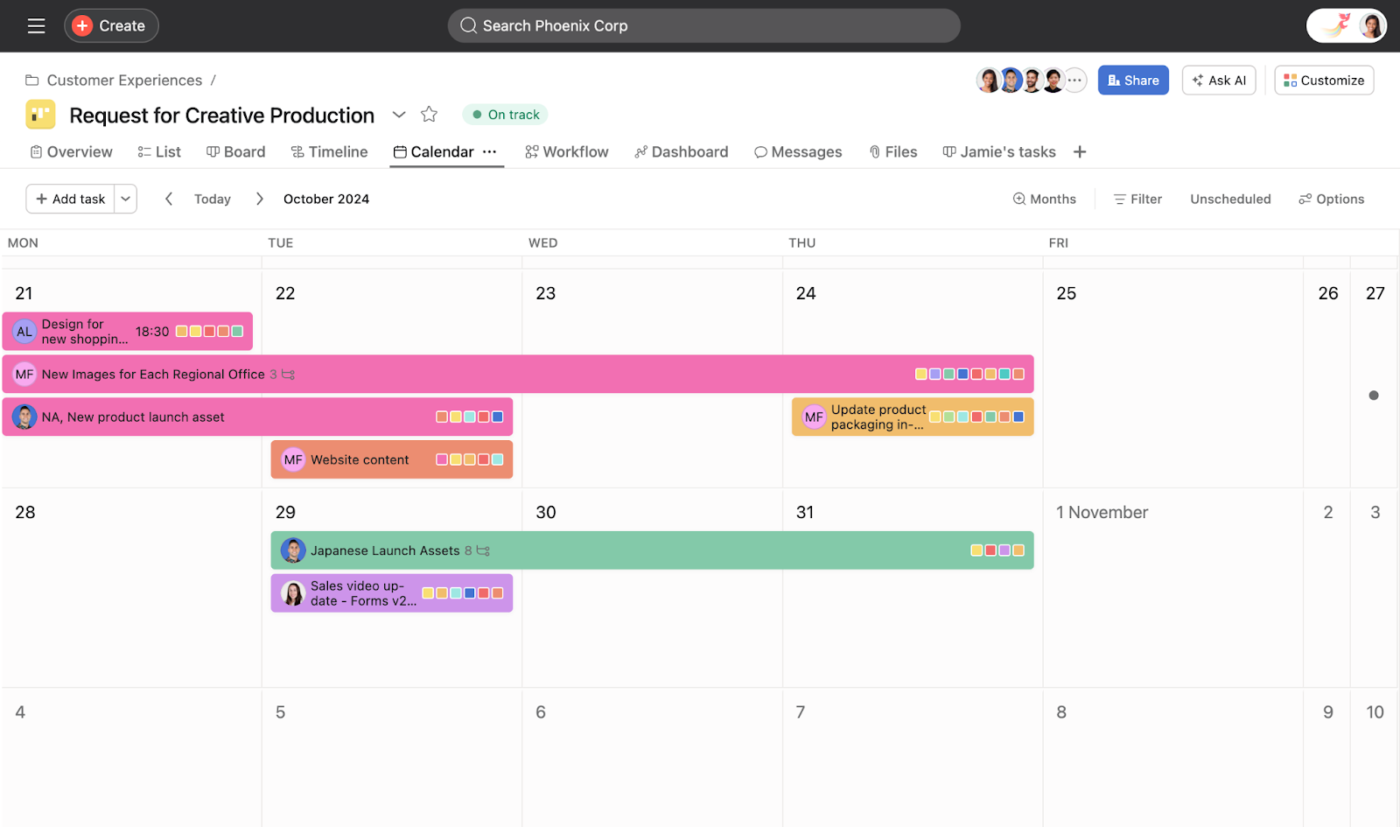
Asana integrates scheduling within a project management framework, offering a tailored approach to teams handling complex workflows. It connects schedules to specific tasks, deadlines, and milestones, making it a reliable tool for managing cross-functional projects.
With multiple views like timeline, calendar, and boards, you can adapt your scheduling process to meet the requirements of both short-term tasks and long-term project objectives.
Asana best features
- Track task dependencies and adjust timelines easily to accommodate changes in project scope
- Manage team workloads with calendar filters and resource allocation tools to avoid burnout and bottlenecks
- Create custom workflows and automate routine tasks to enhance scheduling efficiency
- Monitor milestones and deadlines to ensure project deliverables remain on schedule
Asana limitations
- Complex interface requires a learning curve, especially for teams new to project management tools
- Limited native time tracking capabilities compared to other platforms
Asana pricing
- Personal: Free for up to 10 users
- Starter: $8.50/month per user
- Advanced: $19.21/month per user
- Enterprise: Custom pricing
Asana ratings and reviews
- G2: 4.4/5 (10,600+ reviews)
- Capterra: 4.5/5 (13,200+ reviews)
💡 Pro Tip: Try reverse planning. Start with your end goal and work backward. Instead of filling in the day with tasks, create the day based on the outcome you want to achieve. This helps you visualize the bigger picture and work backward from it in a meaningful way.
5. HubSpot (Best for sales-driven scheduling and customer journey management)
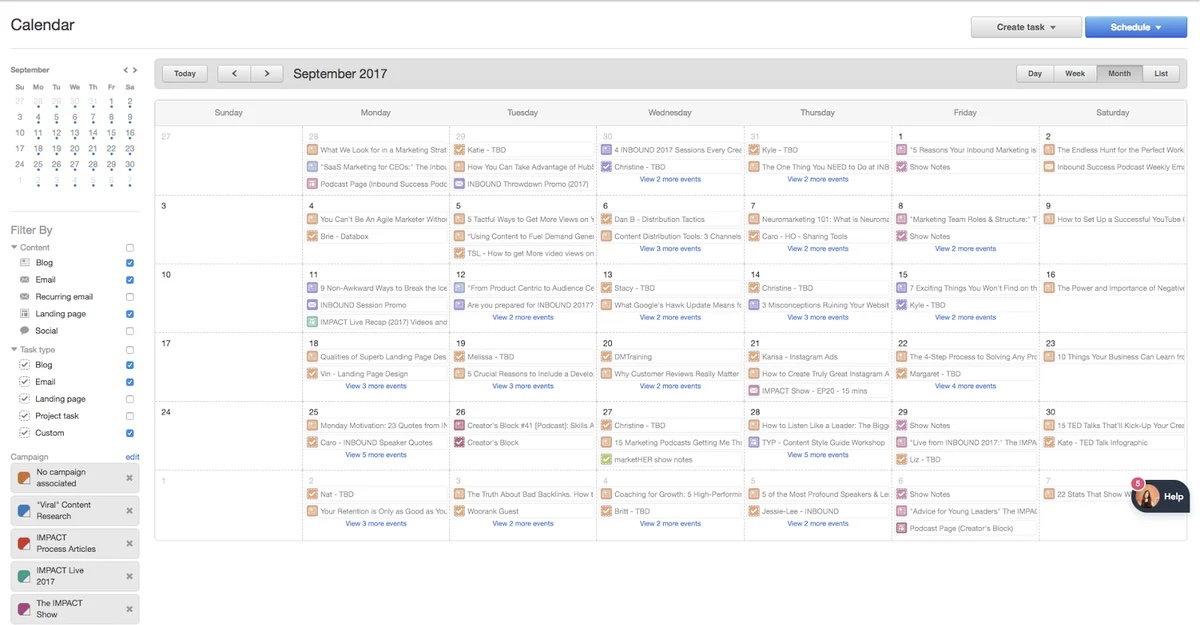
HubSpot combines scheduling capabilities with customer relationship management (CRM), making it a valuable tool for sales and marketing teams. Its unique ability to link meeting schedules directly with customer data and sales pipelines ensures a seamless customer journey.
The tool’s features, such as automated meeting follow-ups and customer portals, support businesses looking to strengthen client relationships while optimizing internal workflows.
HubSpot best features
- Automate follow-up sequences to ensure consistent engagement after meetings
- Provide customers with self-scheduling options through personalized portals
- Enable team-wide scheduling through round-robin assignments and group meeting options
- Customize meeting types and booking rules based on specific stages in the customer journey
HubSpot limitations
- Automation features require extensive setup and CRM knowledge
- Steep learning curve for teams unfamiliar with CRM platforms
HubSpot pricing
- Free
- Starter: Starts at $20/month per user
- Professional: Starts at $1,300/month (includes 5 users)
- Enterprise: Starts at $4,300/month (includes 7 users)
HubSpot ratings and reviews
- G2: 4.4/5 (10,600+ reviews)
- Capterra: 4.5/5 (4,200+ reviews)
🔍 Did You Know? Workload management is a challenge for many workers, with only 20% feeling their workload is under control daily. Meanwhile, 21% said that their work is never under control or manageable.
6. Canva (Best for visual schedule design and content planning)
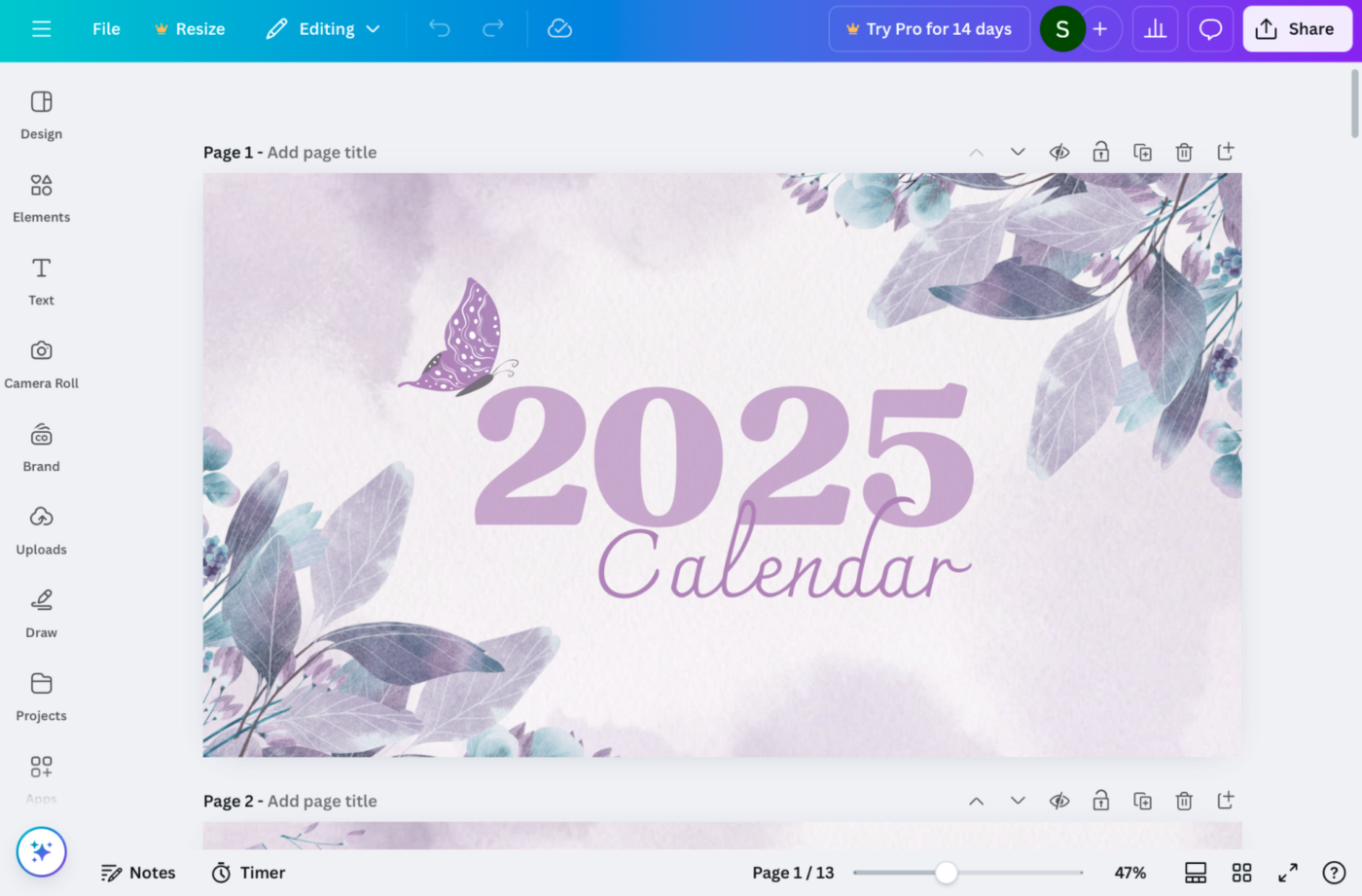
Canva transforms scheduling into an engaging, visually appealing process.
While not a traditional scheduling tool, it excels at creating customizable visual schedules and content calendars for teams or individuals. Its design capabilities allow you to craft schedules that are as functional as they are visually engaging, making it a favorite among marketers, content creators, and social media managers.
Canva best features
- Design visually appealing schedules using an extensive library of templates
- Collaborate in real time to create and edit schedules with your team
- Schedule and plan course, social media posts, and campaigns directly with content calendar integrations
- Instantly resize your schedules and designs with a single click, saving time on manual adjustments
- Save and reuse custom templates to maintain consistency across projects
Canva limitations
- Lacks traditional scheduling logic and real-time event management
- Limited automation capabilities for recurring events or reminders
- No built-in calendar integrations for real-time scheduling updates
Canva pricing
- Free
- Pro: $15/month per user
- Teams: $10/month per user
- Enterprise: Custom pricing
Canva ratings and reviews
- G2: 4.7/5 (4,300+ reviews)
- Capterra: 4.7/5 (12,200+ reviews)
💡 Pro Tip: Swap less enjoyable tasks with ones that you look forward to. Pairing a mundane task with something you enjoy can make both more manageable and boost your overall energy.
7. ZoomShift (Best for employee shift management and labor cost control)

ZoomShift specializes in scheduling for shift-based businesses, providing tools to manage employee availability, shifts, and labor costs. Its features are particularly useful for industries like retail, hospitality, and healthcare, where efficient scheduling has a direct impact on operational performance.
The platform also helps employees with self-service options, making scheduling a collaborative process.
ZoomShift best features
- Track labor costs in real time to stay within budget and optimize scheduling decisions
- Allow employees to swap shifts and request time off directly from their accounts
- Detect schedule conflicts automatically and resolve them quickly
- Integrate time clocks and payroll systems to streamline operations
ZoomShift limitations
- Focuses heavily on shift work, making it less suitable for traditional scheduling needs
- Requires substantial setup time for businesses with multiple locations or complex shift rules
ZoomShift pricing
- Essentials: Free
- Starter: $1/month per user
- Premium: $2/month per user
ZoomShift ratings and reviews
- G2: 4.9/5 (20+ reviews)
- Capterra: 4.5/5 (100+ reviews)
🧠 Fun Fact: Benjamin Franklin mastered scheduling with a daily planner that included six blocks of time scheduled for each day.
📮ClickUp Insight: 37% of workers send follow-up notes or meeting minutes to track action items, but 36% still rely on other, fragmented methods.
Without a unified system for capturing decisions, key insights you need may get buried in chats, emails, docs or spreadsheets. With ClickUp, you can instantly turn conversations into actionable tasks across all your tasks, chats, and docs—ensuring nothing falls through the cracks.
8. Google Sheets (Best for custom schedule creation and data-driven planning)
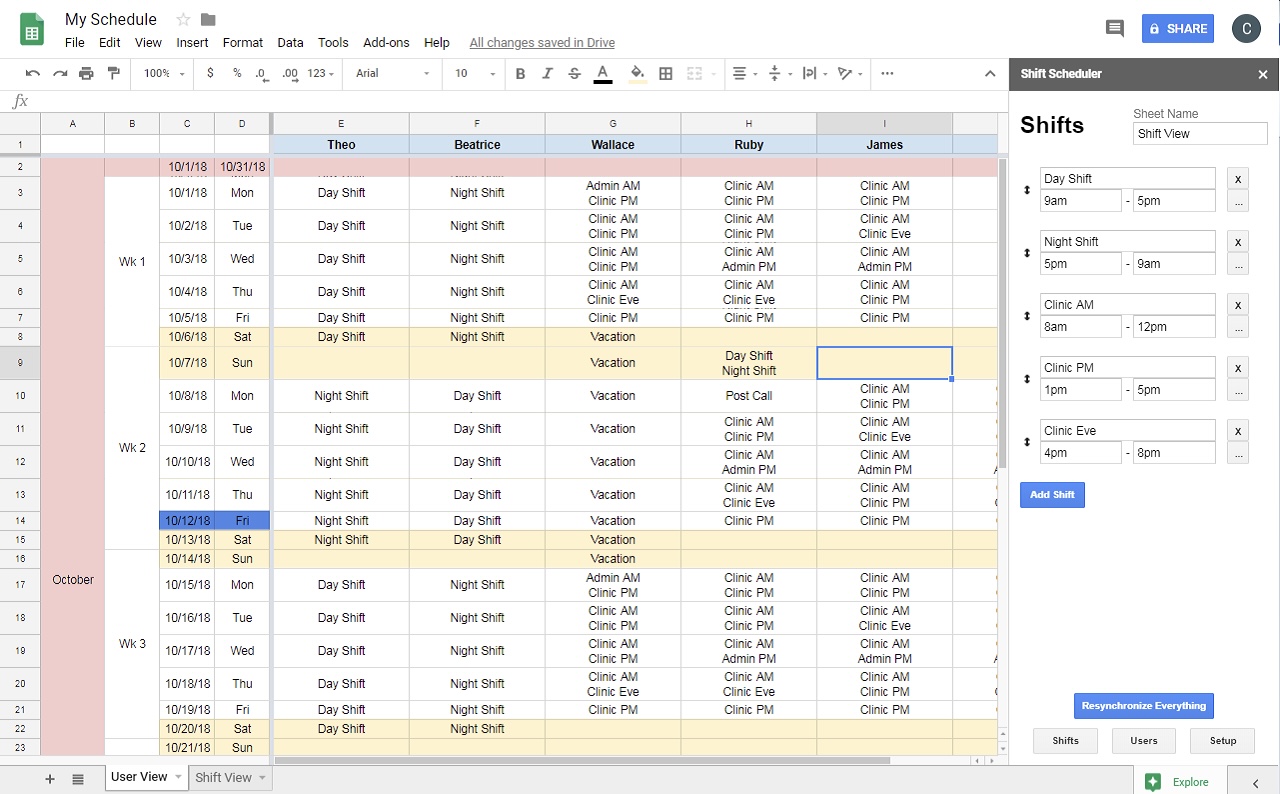
You can create schedules in Google Sheets with high customizability. Unlike traditional scheduling tools, Google Sheets provides the freedom to build schedules tailored to specific needs through custom formulas, conditional formatting, and data validation.
Its real-time collaboration features allow teams to work together seamlessly, making it an excellent choice for businesses or individuals with unique scheduling requirements.
Google Sheets best features
- Build fully customized schedules using formulas and conditional formatting
- Use advanced filtering and data validation to ensure accurate and clean schedules
- Organize schedules across multiple sheets for projects or teams with diverse needs
Google Sheets limitations
- Lacks built-in scheduling automation or real-time reminders for events
- Does not support advanced scheduling logic for overlapping tasks or time zones
Google Sheets pricing
- Free
Google Sheets ratings and reviews
- G2: Not enough reviews
- Capterra: 4.7/5 (12,960+ reviews)
🔍 Did You Know? The earliest sundials, invented around 3500 BCE in ancient Egypt, were simple gnomons. These early timekeepers marked the beginnings of scheduling, helping workers plan their tasks based on the movement of the sun.
9. Sling (Best for small business staff scheduling and team communication)
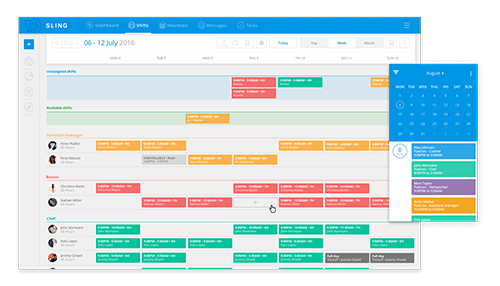
Sling offers a well-rounded solution for small businesses, combining staff scheduling with built-in communication tools.
It allows managers to optimize labor costs, manage employee availability, and handle shift scheduling effortlessly. The platform also provides employees with self-service options, such as shift swapping and time-off requests, ensuring schedules meet business needs without compromising employee satisfaction.
Sling best features
- Communicate instantly with team members using the integrated messaging platform
- Optimize labor costs with tools that track scheduling efficiency
- Allow employees to request time off, swap shifts, or set preferences directly
- Distribute schedules automatically to employees through the mobile app
Sling limitations
- Focused primarily on shift-based scheduling, making it less suitable for broader scheduling needs
- Limited integration capabilities with third-party tools compared to larger platforms
Sling pricing
- Free for up to 50 users
- Premium: $2/month per user
- Business: $4/month per user
Sling ratings and reviews
- G2: 4.4/5 (80+ reviews)
- Capterra: 4.6/5 (170+ reviews)
📖 Also Read: How To Create an Effective Workback Schedule
10. Homebase (Best for comprehensive small business operations management)
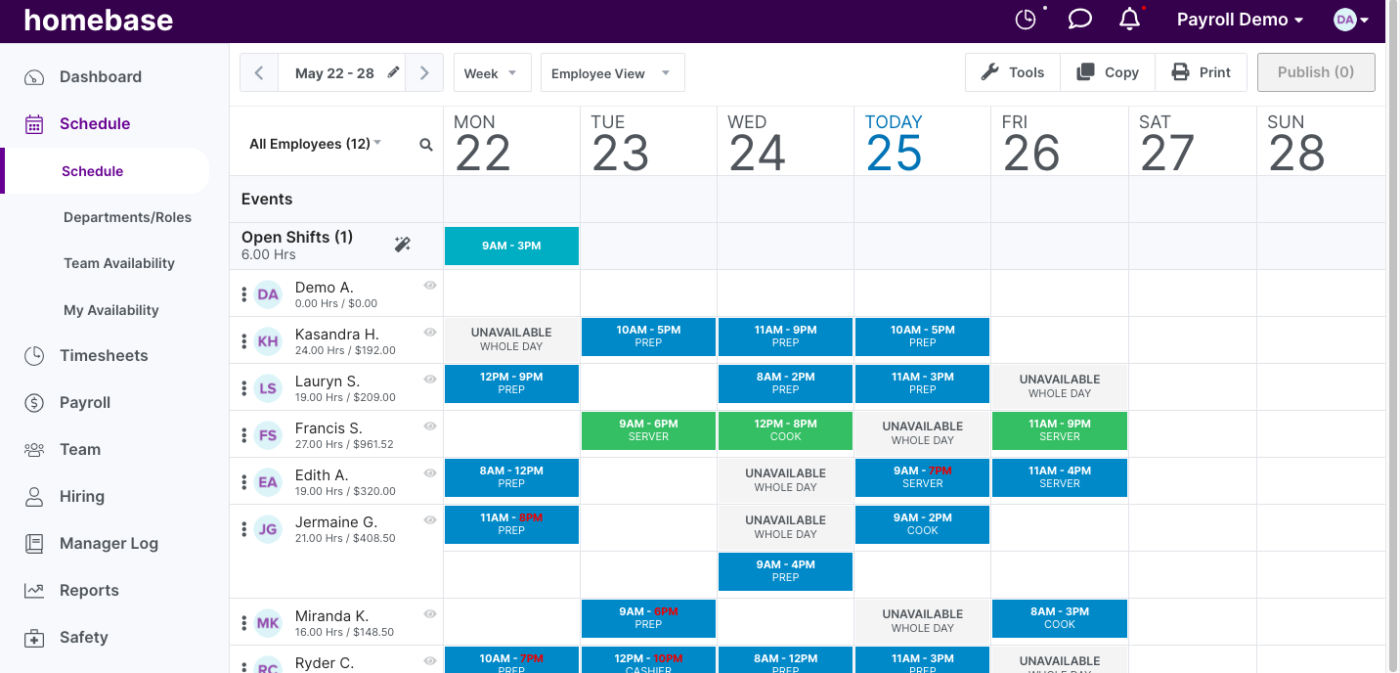
Homebase takes scheduling a step further by integrating it with broader business management tools, such as HR, payroll preparation, and compliance tracking. This platform is ideal for small businesses that want an all-in-one solution to manage operations effectively.
Its features include employee availability tracking, time-off management, and automatic weekly schedule distribution. Added tools for team communication and performance tracking make it a standout choice for businesses focused on streamlining both scheduling and operations.
Homebase best features
- Track employee availability, manage shifts, and ensure labor compliance
- Prepare payroll seamlessly with built-in time tracking and attendance features
- Handle time-off requests and distribute schedules automatically to employees
- Access advanced reporting to track labor costs and identify scheduling patterns
Homebase limitations
- Advanced customization options are restricted to higher-tier plans
- Requires a complex setup process for businesses with multiple locations
Homebase pricing
- Basic: Free
- Essentials: $24.95/month per location
- Plus: $59.95/month per location
- All-in-One: $99.95/month per location
Homebase ratings and reviews
- G2: 4.2/5 (125+ reviews)
- Capterra: 4.6/5 (1,075+ reviews)
💡 Pro Tip: Allocate a specific time slot every week where no screens are allowed. Use this for deep work, nature walks, or creative thinking sessions. This ‘reset’ helps you disconnect to reconnect.
11. Doodle (Best for quick consensus-based meeting coordination)
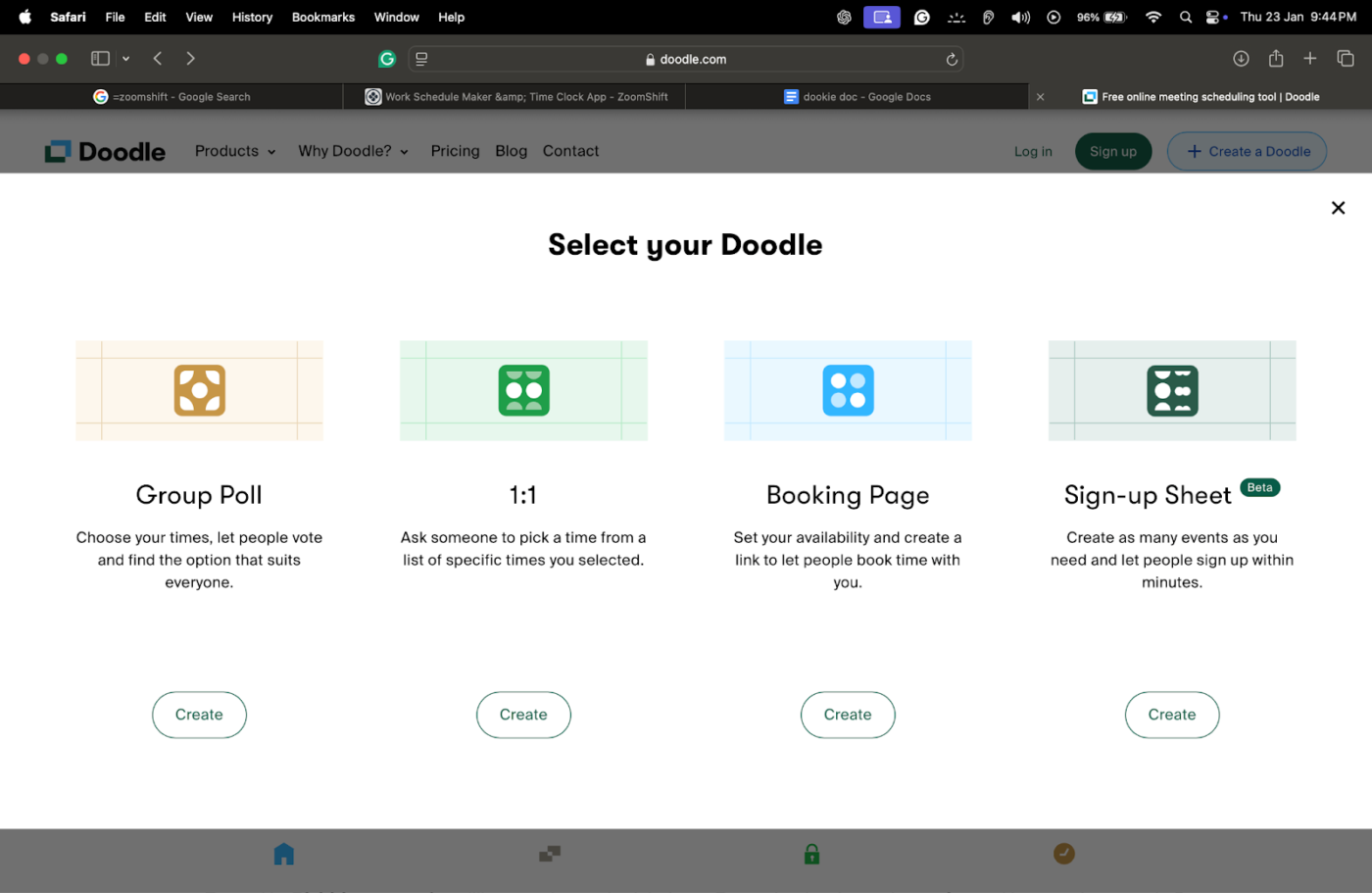
Doodle simplifies group scheduling by focusing on finding common availability among participants quickly.
It allows you to create quick polls, set deadlines for responses, and automatically identify the best meeting time based on participant availability. This simplicity and efficiency make it a preferred tool for businesses and individuals looking to coordinate schedules without the need for complex integrations.
Doodle best features
- Create quick polls to gather availability from multiple participants
- Set deadlines for poll responses to finalize meeting times quickly
- Customize polls with branding options and advanced privacy settings
- Use multiple time zone support to schedule international meetings effectively
Doodle limitations
- Basic reporting capabilities do not provide detailed insights into scheduling trends
- Focuses exclusively on meeting coordination, offering no broader scheduling functionalities
Doodle pricing
- Free
- Pro: $14.95/month per user
- Team: $19.95/month per user (for five users)
Doodle ratings and reviews
- G2: 4.4/5 (2,060+ reviews)
- Capterra: 4.6/5 (1,810+ reviews)
📖 Also Read: How to Create a Healthy Work-From-Home Schedule
Double Click on Time-Saving Brilliance
Time is a resource you can’t get back, so why not make the most of it? A great schedule maker can take the hassle out of planning, keeping your goals on track without the stress.
With so many incredible free options to choose from, you’re just a few clicks away from turning chaos into clarity.
Among these tools, ClickUp stands out as the ultimate all-in-one solution. From managing your personal schedule to planning team projects, ClickUp Calendar View helps you organize tasks and events.
Plus, the powerhouse combo of ClickUp AI Notetaker + ClickUp Brain refines workflows by capturing key points and automatically organizing tasks. With its customizable features and integrations, ClickUp turns chaos into clarity, making it the ideal choice for staying organized in both personal and team settings.
Sign up for ClickUp today! ✅





